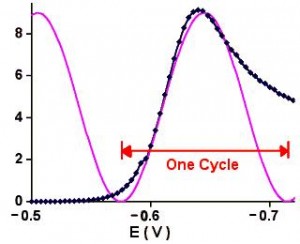Being able to scan rapidly does not insure that the results will be meaningful! The speed of the current measurement circuitry is often the limiting factor!
The key to finding the practical limit for obtaining meaningful fast scan cyclic voltammograms is nearly always finding the speed of the current measurement. Here the researcher has an important role to play: It is the researcher who must select the current range to use for fast cyclic voltammetry. The autoranging capability of many modern computer controlled potentiostats generally cannot be used because the decisions cannot be made and implemented fast enough.
Because of stray (and deliberately added) capacitances, the current measuring circuitry generally becomes slower as the full scale current decreases. Obtaining the fastest scan requires a tradeoff of scan rate, electrode size, analyte concentration, current range, and acceptable noise in the measurement. It is often better to use a less sensitive current scale (larger full scale current) coupled with a larger pre-amplification factor on the ADC, data recorder, or oscilloscope used. Although this approach is likely to increase the noise in the measurement, it does allow a higher scan rate to be realized.
The speed or frequency response of each current range can sometimes be found in the manufacturer’s data sheet under “Current Measurement” or sometimes as a “System Specification” if a specific current range is quoted along with the bandwidth.
This number can be roughly translated into a scan rate by looking at Figure 1.
A linear scan for cadmium with a sine wave superimposed.This number can be roughly translated into a scan rate by looking at the Figure. A linear scan for cadmium ( 2 e- ) is shown along with a sine wave that approximates the rising portion of the wave. One cycle of this sine wave is about 0.1 volts wide. If the bandwidth for a particular current range is given as 10 kHz, for example, then this is roughly equivalent to scanning 0.1 V in one cycle of 10 kHz, (or in 0.1 ms). The equivalent scan rate is 1000 V/s. [ 0.1 volts divided by 0.0001 s (=0.1 ms) ]
This probably represents an upper limit if traditional bandwidth specifications have been quoted. Bandwidths are often quoted as that frequency for which the amplitude is 70% of the ideal (the -3 db frequency.) As a consequence, a CV recorded at the equivalent scan rate will be distorted, both in shape and amplitude, by the response of the current measuring circuit.
Once again, scan rates estimated by the methods illustrated here should be taken with a grain of salt. They are only approximations, not absolutes.

